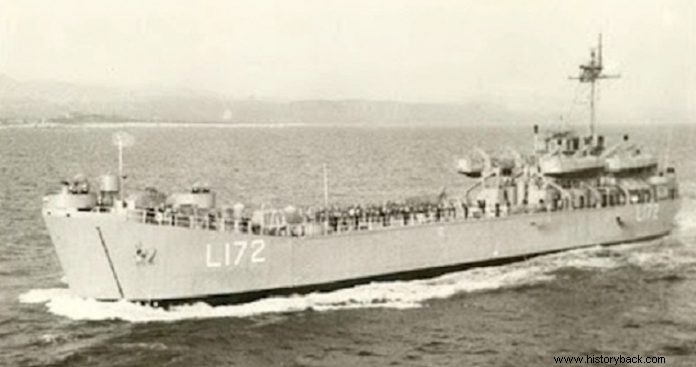
The tanker "Lesvos" was launched in 1942 as the USS "Boone County". It was an LST 1 (Landing Ship Tanks) type tanker. The vessel had a displacement, with a full load, of about 4,000 tons. It was 100 m long and had a maximum speed of only 12 knots. It was armed with 40 and 20 mm anti-aircraft guns
His Panteli Karika
SOURCE: SLpress
It was given to Greece in 1960 and named "Lesvos" (L-172). In 1974 its captain was pilot Eleftherios Chandrinos. On July 13, 1974, he set sail from the small port of Kechria, bound for Cyprus.
He arrived in Cyprus and after disembarking a force of replacements for the ELDYK men serving on the island, sailed from Cyprus on July 19, in the afternoon, carrying 450 men who had completed their service with the ELDYK and were returning to Greece.
Voluntary involvement
On the morning of July 20, he found the Greek ship sailing south of Limassol. There his captain, pilot at the time, Eleftherios Chandrinos, received a signal informing him of the Turkish landing and ordering him to disembark the men he was transporting to Limassol, first and then to Paphos.
Immediately the "Lesvos" sailed towards Paphos and disembarked the men. Admiral Chandrinos, however, was not content with that, but remained in the area and with the ship's guns - 40 mm anti-aircraft Bofors - began to sweep the positions of the Turkish Cypriots.
Firing nearly 1,000 shells, he forced two battalions of Turkish Cypriots to raise a white flag. With the support of "Lesvos", the Greek forces immediately prevailed and the Turkish Cypriots began to surrender by the dozens . Immediately afterwards, Chandrinos sailed south, towards Egypt, to mislead the Turks who, logically, would be looking for him to the northwest.
As "Lesvos" was moving away, the Turks had a panic attack, talking about the existence of a Greek convoy, with nine transports and five accompanying warships, sailing, carrying reinforcements, towards Cyprus. Immediately three destroyers supporting the landing Turkish forces, "Kocatepe", "Adatepe" and "Fevzi Cakmak" were sent to investigate for Greek ships.
Massacre of Turks
The confusion was great and together with the navy, the Turkish air force was sent. Turkish F-1014G and F-100 fighters spotted the three American-made Gearing-class destroyers (Fram I and Fram II conversions), externally identical to the corresponding Greek ones, which they assumed were Greek and attacked them.
The Turkish ships realized that the aircraft were Turkish and tried to alert. But the Turkish pilots thought that the fact that they were speaking in Turkish on the radio and that the boats clearly carried the Turkish flag was a trick by the Greeks to mislead them.
So they attacked. When they finally realized the mistake it was too late. The "Kocatepe" was a burning wreck, which soon sank, the other two ships being very badly damaged. Losses in men were also heavy.
From the anti-aircraft fire of the ships, which responded to the attacks they were receiving, finally five Turkish fighters were hit, one of which went down . To this day, however, the Turks insist that there was indeed a Greek convoy, which was "intercepted with the sacrifice" of the Turkish navy!
Regarding the heroes admiral El. Chandrino, his achievement was not officially recognized because Greece, until very recently, refused to admit that in 1974 it fought with Turkey.
Vice-admiral, now, Chandrinos was later sent as a military attache to Turkey. In 1986, he was the victim of a traffic accident, near Komotini. With great effort he managed to recover, but he died in 1994.
